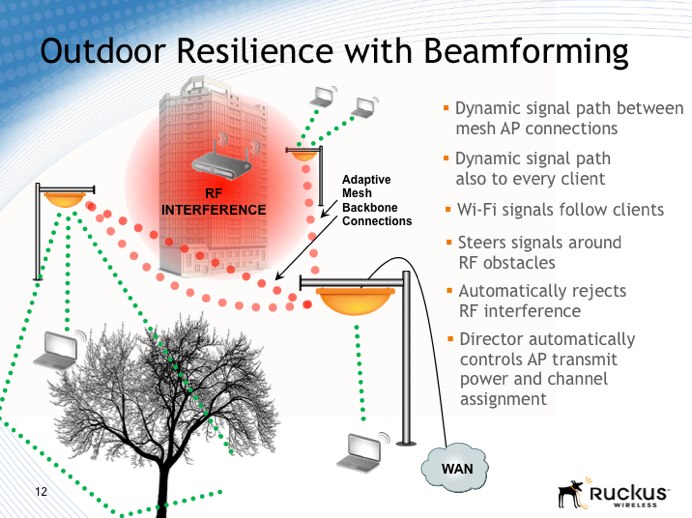Visions of laser beams filling the skies to boost WiFi's strength

Several years ago, I wrote about an outdoor wireless mesh networking project, a downtown area that would be blanketed with a WiFi signal by access points and routers scattered throughout the area - in bus shelters, on light poles and even in some trees.
The problem with a plan like that, though no one seemed to recognize it at the time, was that the signal had to blanket the entire area so that when the person Web surfing on a laptop moved from the picnic table to the shady spot under a tree, the signal wouldn't lose its strength along the way.
Today, there's a better way. Ruckus Wireless this week announced outdoor dual-band 802.11n and single-band 802.11g WiFi access points that use a technology called Dynamic Beamforming to tackle issues like interference and physical obstructions and make the outdoor WiFi experience better.
Gallery: Ruckus outdoor access points
Just the use of the word beam makes me picture the red laser lights that the bank robbers in the movies have to get past to steal the jewels from the vault. Instead, this beam follows me and my iPod Touch, mysteriously pointing directly at my WiFi-enabled device from the skies to make sure that I can quickly post a Facebook status update or download a new game. If I walk into a park and sit down under a shady tree, the beam ricochets off of other trees, bushes, picnic tables and other obstructions just to reach my device.
As it turns out, that's more or less the idea behind Ruckus' technology - minus the Hollywood laser beams, of course.
It's all powered by a smart antenna technology called BeamFlex that resides in the router and continually picks and finds the best signal path to a client, dodging interferences and adapting to moves.
The company touts added benefits of its system for a number of scenarios, including:
- extending a wireless LAN to outdoor areas of places like school campuses or vacation resorts.
- enhancing the service for high-density areas such as apartment buildings
- taking some of the demand off of congested 3G cellular networks - a growing problem as mobile Web surfing and apps grow in popularity.
Remember what a breakthrough it was when you could tap into the WiFi signal from a lounge chair of a hotel lobby or the patio seats at the neighborhood Starbucks? BeamFlex isn't trying to compete with the WiFi providers who still offer those services. Instead, it's looking to enhance those services, to make them stronger and faster, as well as more cost-efficient.
WiFi is good - but it can be better. Check out the list below to see how Ruckus thinks that outdoor WiFi could be better:
